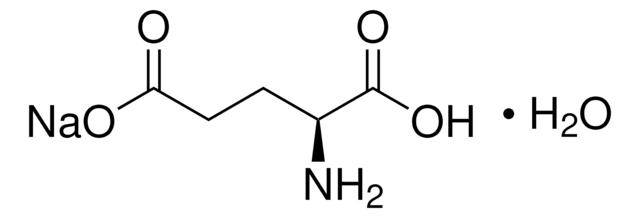W328502
L-Glutamic acid
FCC
Synonym(s):
(S)-2-Aminopentanedioic acid, Glu
About This Item
Recommended Products
biological source
corn
Quality Level
grade
Kosher
reg. compliance
FCC
FDA 21 CFR 172.320
FDA 21 CFR 182.1045
Assay
98.5-101.5% dry basis (perchloric acid titration)
form
powder or crystals
optical activity
[α]20/D +32°, c = 10 in 2 M HCl
mp
205 °C (dec.) (lit.)
solubility
water: soluble 8.64 g/L at 25 °C
density
1.54 g/cm3 at 20 °C
cation traces
As: ≤3 ppm
Cd: ≤1 ppm
Hg: ≤1 ppm
Pb: ≤5 ppm
application(s)
flavors and fragrances
food allergen
no known allergens
Organoleptic
baked
SMILES string
N[C@@H](CCC(O)=O)C(O)=O
InChI
1S/C5H9NO4/c6-3(5(9)10)1-2-4(7)8/h3H,1-2,6H2,(H,7,8)(H,9,10)/t3-/m0/s1
InChI key
WHUUTDBJXJRKMK-VKHMYHEASA-N
Gene Information
human ... CCR2(1231) , GRIA1(2890) , GRIA2(2891) , GRIA4(2893) , GRIK1(2897) , GRIK2(2898) , GRIK3(2899) , GRIK5(2901) , GRIN2B(2904) , GRM2(2912) , SLC1A1(6505) , SLC1A2(6506)
rat ... Gria1(50592) , Grik1(29559) , Grik2(54257) , Grik4(24406) , Grin2a(24409) , Grm1(24414) , Grm2(24415) , Grm3(24416) , Grm4(24417) , Grm5(24418) , Grm6(24419) , Grm7(81672) , Slc1a2(29482)
Looking for similar products? Visit Product Comparison Guide
General description
Biochem/physiol Actions
Disclaimer
Storage Class Code
11 - Combustible Solids
WGK
WGK 1
Flash Point(F)
Not applicable
Flash Point(C)
Not applicable
Personal Protective Equipment
Regulatory Listings
Regulatory Listings are mainly provided for chemical products. Only limited information can be provided here for non-chemical products. No entry means none of the components are listed. It is the user’s obligation to ensure the safe and legal use of the product.
JAN Code
W328502-10KG-K:
W328502-10KG:
W328502-SAMPLE-K:
W328502-SAMPLE:
W328502-25KG:
W328502-BULK-K:
W328502-1KG:
W328502-VAR-K:
W328502-25KG-K:
W328502-5KG-K:
W328502-1KG-K:
W328502-5KG:
Choose from one of the most recent versions:
Already Own This Product?
Find documentation for the products that you have recently purchased in the Document Library.
Customers Also Viewed
Chromatograms
application for HPLCOur team of scientists has experience in all areas of research including Life Science, Material Science, Chemical Synthesis, Chromatography, Analytical and many others.
Contact Technical Service





